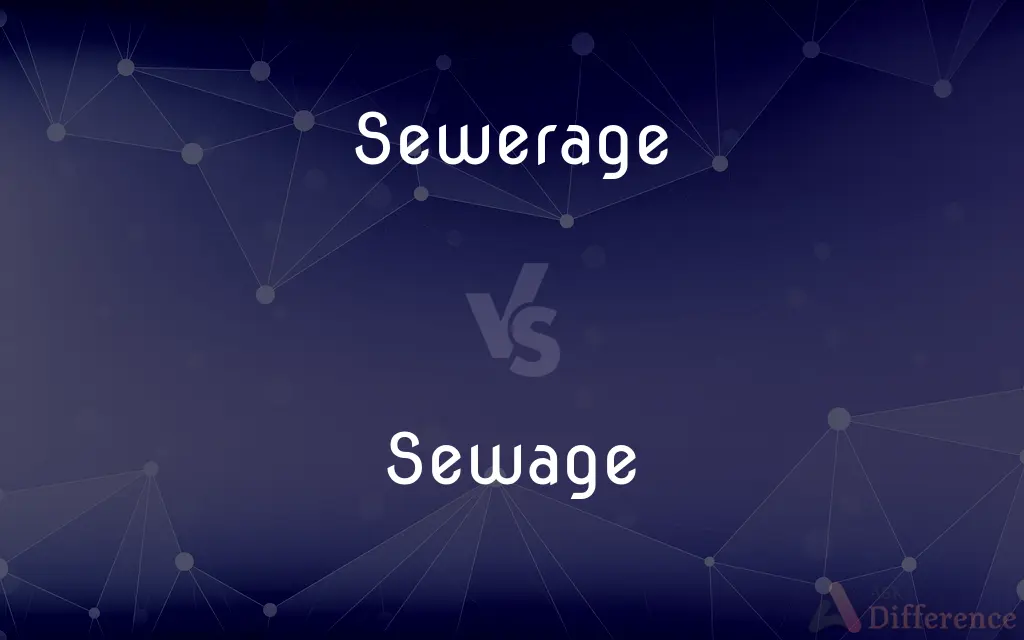Sewerage vs. Sewage — What's the Difference?
By Fiza Rafique & Maham Liaqat — Updated on February 27, 2024
Sewerage refers to the infrastructure for conveying sewage, including pipes and treatment facilities. Sewage is the waste water and solids conveyed through this system, typically from households and industries.

Difference Between Sewerage and Sewage
Table of Contents
ADVERTISEMENT
Key Differences
Sewerage is the comprehensive network of pipes, pumps, and treatment plants designed for transporting and treating sewage before it's released into the environment. This system includes the physical infrastructure and the services involved in sewage removal and treatment. Sewage, in contrast, consists of the actual waste material that flows through the sewerage system, including water and solids from residential, industrial, and commercial sources.
Sewerage represents the engineering and facilities aspect of waste management, sewage is the substance that needs to be managed. The distinction is important in discussions about public health, urban planning, and environmental protection. Sewerage systems are critical for ensuring that sewage is effectively collected, treated, and disposed of or reused in a manner that minimizes environmental impact.
The design and maintenance of sewerage systems are crucial for preventing public health issues by ensuring that sewage is not exposed to the environment or communities. Conversely, the composition and volume of sewage challenge engineers to design sewerage systems that can efficiently handle and treat waste to meet safety and environmental standards.
The relationship between sewerage and sewage is one of container and content; sewerage is the system that transports and treats, while sewage is what is being transported and treated. Effective sewerage systems are key to managing sewage in a way that supports public health, sanitation, and environmental sustainability.
Comparison Chart
Definition
The system for removing and treating sewage.
The waste water and solids transported by sewerage.
ADVERTISEMENT
Components
Pipes, pumps, and treatment facilities.
Water, human waste, and industrial effluents.
Function
To transport and treat waste material.
To be treated and disposed of or reused.
Related to
Infrastructure and engineering.
Public health and environmental protection.
Importance
Ensures the safe and efficient removal and treatment of sewage.
Poses risks to health and environment if not properly managed.
Compare with Definitions
Sewerage
The infrastructure for sewage disposal.
The city's sewerage system is undergoing a major upgrade.
Sewage
Material that needs to be treated to prevent pollution.
Treating sewage properly is essential for protecting rivers.
Sewerage
Systems designed for wastewater collection and treatment.
Effective sewerage systems reduce environmental pollution.
Sewage
Wastewater from homes and businesses.
The sewage was treated at the local plant before being released.
Sewerage
A network of pipes, pumps, and treatment plants.
The new sewerage facility will increase the city's treatment capacity.
Sewage
The liquid and solid waste in sewer systems.
Heavy rain can cause the sewage system to overflow.
Sewerage
The engineering and management of sewage systems.
Sewerage planning is crucial for urban development.
Sewage
A mixture of water and waste substances.
Sewage treatment removes harmful contaminants from wastewater.
Sewerage
Services related to sewage removal.
The municipality has improved its sewerage services to prevent overflows.
Sewage
Waste that includes human feces, urine, and water.
The sewage composition varies depending on the source.
Sewerage
Sewerage (or sewage system) is the infrastructure that conveys sewage or surface runoff (stormwater, meltwater, rainwater) using sewers. It encompasses components such as receiving drains, manholes, pumping stations, storm overflows, and screening chambers of the combined sewer or sanitary sewer.
Sewage
Sewage (or domestic sewage, domestic wastewater, municipal wastewater) is a type of wastewater that is produced by a community of people. It is characterized by volume or rate of flow, physical condition, chemical and toxic constituents, and its bacteriologic status (which organisms it contains and in what quantities).
Sewerage
The provision of drainage by sewers
A proper sewerage system
Sewage
Liquid and solid waste carried off in sewers or drains.
Sewerage
Removal of waste materials by means of a sewer system.
Sewage
A suspension of water and solid waste, transported by sewers to be disposed of or processed.
Sewage
The contents of a sewer or drain; refuse liquids or matter carried off by sewers
Sewage
Waste matter carried away in sewers or drains
Common Curiosities
What are the main components of a sewerage system?
The main components include sewage pipes, pumps for conveying sewage, and treatment facilities for processing the waste.
Can sewage be treated for reuse?
Yes, sewage can be treated to remove contaminants, making it safe for reuse in agriculture, landscaping, or industrial processes.
How does sewerage impact environmental health?
Properly designed and maintained sewerage systems minimize environmental health risks by treating sewage before it's released into the environment.
What is sewage?
Sewage is the waste water and solids that flow through sewerage systems, originating from residential, industrial, and commercial sources.
How are sewerage systems designed to handle heavy rainfall?
Systems are designed with overflow mechanisms and storage capacity to manage excess water during heavy rainfall, preventing untreated sewage from entering the environment.
What happens to sewage in a treatment plant?
Sewage undergoes various processes to remove solids, organic matter, and pathogens, making the water safe for discharge or reuse.
What are the challenges in managing sewage in rapidly growing cities?
Challenges include overburdened infrastructure, increased pollution, and the need for sustainable waste management solutions.
What is sewerage?
Sewerage is the system and infrastructure for removing and treating sewage, including pipes, pumps, and treatment plants.
How does urban development affect sewerage systems?
Urban development increases the load on sewerage systems, requiring upgrades or expansions to handle additional sewage volume and prevent overflows.
Why is it important to differentiate between sewerage and sewage?
Differentiating helps in understanding the scope of infrastructure challenges (sewerage) versus the treatment and management of waste material (sewage).
What innovations are improving sewage treatment?
Innovations include advanced biological treatment processes, water recycling technologies, and energy-efficient systems.
Can improper disposal of sewage lead to health issues?
Yes, improper disposal can contaminate water sources, leading to waterborne diseases and health risks.
How does climate change impact sewerage systems?
Climate change, through increased rainfall and flooding, can overwhelm sewerage systems, leading to sewage overflow and environmental contamination.
How is sewage composition analyzed for treatment?
Sewage composition is analyzed to determine contaminant levels, which guides the selection of appropriate treatment processes to ensure environmental and health safety standards are met.
What role do municipalities play in managing sewerage and sewage?
Municipalities are responsible for the construction, maintenance, and operation of sewerage systems and for ensuring that sewage is treated according to public health and environmental standards.
Share Your Discovery

Previous Comparison
Behest vs. Bequest
Next Comparison
Dealer vs. PusherAuthor Spotlight
Written by
Fiza RafiqueFiza Rafique is a skilled content writer at AskDifference.com, where she meticulously refines and enhances written pieces. Drawing from her vast editorial expertise, Fiza ensures clarity, accuracy, and precision in every article. Passionate about language, she continually seeks to elevate the quality of content for readers worldwide.
Co-written by
Maham Liaqat














































